
Fountain of River Commerce and Navigation (1840)
The two fountains in the Place de la Concorde were designed by Jacques-Ignace Hittorff on the theme of rivers and seas.
Both fountains had the same form: a stone basin; six figures of tritons (son of Poseidon and Amphitrite, portrayed as having the head and trunk of a man and the tail of a fish.) or naiads (water nymph ) holding fish spouting water; six seated allegorical figures, their feet on the prows of ships, supporting the pedestal, of the circular vasque (bowl); four statues of different forms of genius in arts or crafts supporting the upper inverted upper vasque; whose water shot up and then cascaded down to the lower vasque and then the basin.



-VIDEO : ◄ Place de la Concorde, Paris [HD] ►
The two fountains in the Place de la Concorde were designed by Jacques-Ignace Hittorff on the theme of rivers and seas.
Both fountains had the same form: a stone basin; six figures of tritons (son of Poseidon and Amphitrite, portrayed as having the head and trunk of a man and the tail of a fish.) or naiads (water nymph ) holding fish spouting water; six seated allegorical figures, their feet on the prows of ships, supporting the pedestal, of the circular vasque (bowl); four statues of different forms of genius in arts or crafts supporting the upper inverted upper vasque; whose water shot up and then cascaded down to the lower vasque and then the basin.



-VIDEO : ◄ Place de la Concorde, Paris [HD] ►
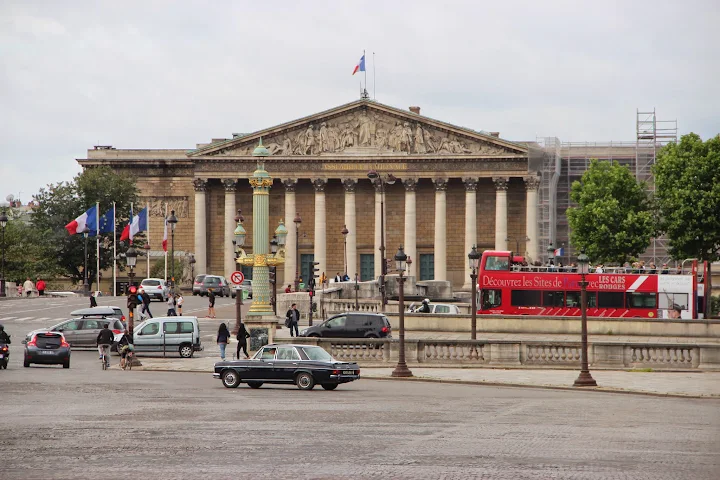
The Palais Bourbon, a palace located in the 7th arrondissement ofParis, on the left bank of the Seine, across from the Place de la Concorde. It is the seat of the French National Assembly, the lower legislative chamber of the French government

Palais Bourbon seen from the Quai des Tuileries
L'Assemblée Nationale, le Pont de la Concorde, depuis le quai des Tuileries.


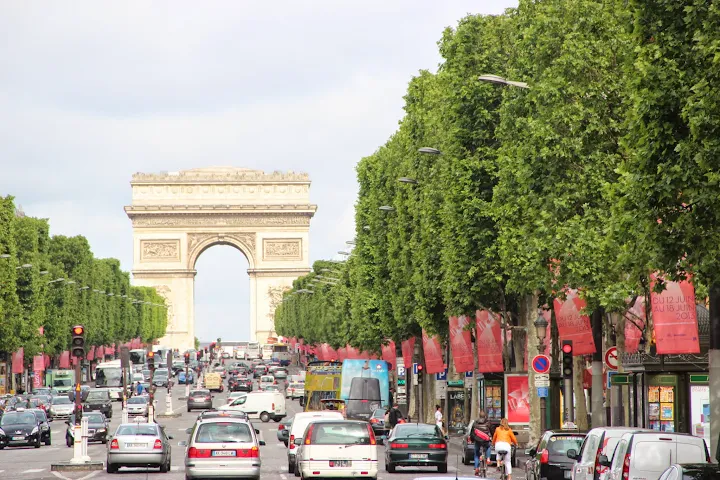


2013-06-15_ Eiffel Tower Paris, France.

Aerial view of the Hôtel des Invalides and the Esplanade in Paris. In the background, the Seine river with the Alexander III bridge and the Petit and Grand Palais.Photo by


The church of Les Invalides (1671–1678) was built by Louis XIV as the chapel of a hospital for war-wounded and retired soldiers.
CATHEDRAL OF SAINT-LOUIS DES INVALIDES

Nave of Saint-Louis-des-Invalides Cathedral, Paris, France.According to an old tradition, war trophies decorate the vault of the chapel of Saint-Louis-des-Invalides.

Court of the museum of the Army_(Cour d'honneur des Invalides)
-VIEW :Les Invalides _From Wikipedia
The Invalides Complex
The complex of buildings known as Les Invalides sits in Paris's 7th arrondissement and consists of museums and monuments related to the military history of France. The most recognizable and well-known part of Les Invalides is the Dôme des Invalides,
a gold-domed building now used as a burial site for a number of the country's war heroes.
Its History
Proposed by Louis XIV in 1670 as a home for "invalids" - disabled and impoverished war veterans, Les Invalides was designed by Libéral Bruant and completed in 1676.
That same year King Louis XIV - the Sun King - charged architect Jules Hardouin Mansart with the task of creating a separate private chapel at the Invalides for exclusive use of the royal family. It is this gold-domed church, completed in 1708 by de Cotte after Mansart died, that many
individuals recognize. Inspired by Rome's St. Peter's Basilica, this chapel, known as Église du Dôme, is considered one of the world's most exciting examples of French Baroque architecture.
The dome itself is 107 meters high (351 ft), making it one of the tallest monuments in Paris, and was centrally placed in order to dominate the court of honor - one of 15 courtyards at the complex, designed for military parades. The inside of the dome was painted by Charles de La Fosse, disciple of 18th century well-known French painter, Charles Le Brun.
Napoleon's Tomb
Napoleon Bonaparte,
whose last wish was to be buried at the banks of the Seine River, died on the island of St. Helena and was buried there until King Louis-Philippe decided to have his body exhumed and returned to Paris in 1840. He chose to have him entombed at Les Invalides.
In order to accommodate the tomb, architect Louis Visconti had to redesign the high altar of the domed church. Upon completion in 1861, the remains of Napoleon's body were then placed in 6 coffins inside a tomb, which was fashioned from red Finnish porphyry with a green granite base, and placed inside the crypt.
A dozen large figures are arranged around the tomb, intended to
represent Napoleon's victories. An accompanying statue of the French leader himself, dressed in coronation robes, stands nearby and measures more than 8 feet high (2.4 m), in stark contrast to the emperor's diminutive size.

DÔME DES INVALIDES, TOMB OF NAPOLEON I


The Dôme des Invalides, the Dome Church
Napoleon I on his Imperial Throne, 1806.
-VIDEO :Napoleon Bonaparte - Icon Of Power
The Emperor Napoleon in His Study at the Tuileries, by Jacques-Louis David, 1812
Napoleon Bonaparte ,(15 August 1769 – 5 May 1821) was a French military and political leader who rose to prominence during the latter stages of the French Revolution and its associated wars in Europe.
As Napoleon I, he was Emperor of the French from 1804 to 1814 and again in 1815. He implemented a wide array of liberal reforms across Europe, including the abolition of feudalism and the spread of religious toleration. His legal code in France, the Napoleonic Code, influenced numerous civil law jurisdictions worldwide. Napoleon is remembered for his role in leading France against a series of coalitions in the Napoleonic Wars. He won the majority of his battles and seized control of most of continental Europe in a quest for personal power and to spread the ideals of the French Revolution. Widely regarded as one of the greatest commanders in history, his campaigns are studied at military academies worldwide. He remains one of the most studied political and military leaders in all of history.
Napoleon was born in Corsica in a family of noble Italian ancestry that had settled in Corsica in the 16th century. He spoke French with a heavy Corsican accent. Well-educated, he rose to prominence under the French First Republic and led successful campaigns against the enemies of the French revolution who set up the First and Second Coalitions, most notably his campaigns in Italy.
He took power in a coup d'état in 1799 and installed himself as First Consul. In 1804 he made himself emperor of the French people. He fought a series of wars —the Napoleonic Wars—that involved complex coalitions for and against him. After a streak of victories, France secured a dominant position in continental Europe, and Napoleon maintained the French sphere of influencethrough the formation of extensive alliances and the elevation of friends and family members to rule other European countries as French vassal states.
The Peninsular War (1807–14) and the French invasion of Russia in 1812 marked major military failures. His Grande Armée was badly damaged and never fully recovered. In 1813, the Sixth Coalition defeated his forces at the Battle of Leipzig and his enemies invaded France. Napoleon was forced to abdicate and go in exile to the Italian island of Elba. In 1815 he escaped and returned to power, but he was finally defeated at the Battle of Waterloo in June 1815. He spent the last 6 years of his life in confinement by the British on the island of Saint Helena. An autopsy concluded he died of stomach cancer but there has been debate about the cause of his death, and some scholars have speculated he was a victim of arsenic poisoning.
-MOVIE :
Napoleon Bonaparte: The Conquerors of Europe Continent (Full Documentary)
 Napoleon Biography - Facts, Birthday, Life Story
Napoleon Biography - Facts, Birthday, Life Story
The Battle of Waterloo was fought on Sunday, 18 June 1815, near Waterloo in present-dayBelgium, then part of the United Kingdom of the Netherlands. A French army under the command of Napoleon was defeated by the armies of the Seventh Coalition, comprising an Anglo-allied army under the command of the Duke of Wellington combined with a Prussian army under the command of Gebhard von Blücher.
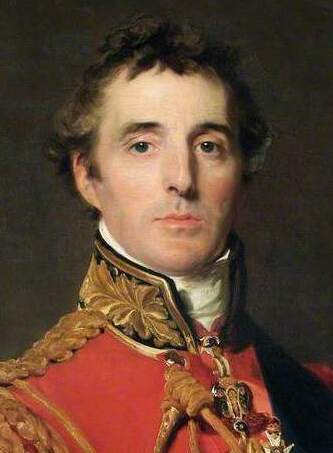
The Duke of Wellington, a veteran general of the Peninsular War, commanded an army of British, Dutch, and German forces.

The Duke of Wellington, a veteran general of the Peninsular War, commanded an army of British, Dutch, and German forces.
-200th anniversary of the Battle of Waterloo, 18th June 1815
The year is 1816, and NAPOLEON, held prisoner by the British on the island of St. Helena, is telling the young English girl BETSY his life story. His meteoric rise to military prominence begins with his victory over the Royalists in 1795, which is followed by campaigns in Italy and Egypt. He marries the young and capricious JOSEPHINE DE BEAUHARNAIS, the love of his life, who unfortunately cannot bear him any children. After a coup d'état he seizes power in France and crowns himself Emperor of the French in 1804. After his decisive victory at Austerlitz, Napoleon reorganizes Europe and makes his relatives into princes and kings. Continuing resistance by the Spanish results in some initial losses, however. Meanwhile, Napoleon is increasingly fascinated by other women, including the Polish patriot MARIA WALEWSKA, who bears him a son. Napoleon intends to found an imperial dynasty, however, to strengthen his position. After divorcing Josephine, he marries the Austrian princess MARIE-LUISE, who gives birth to an imperial heir. Napoleon's attempt to bring the Czar of Russia to his knees results in a massive catastrophe for his army, and prompts the European powers to form an alliance against him. In 1814 he is defeated in the Campaign of France, and is exiled to the island of Elba. Napoleon gathers all his strength one more time, however, returns to France and wins the hearts of its people again. With a new army he goes into battle against the Allies in 1815 at Waterloo.
-MOVIE :Napoleon (2002)
Napoleon at the Battle of Austerlitz, by François Gérard 1805. The Battle of Austerlitz, also known as the Battle of the Three Emperors, was Napoleon's greatest victory, where the French Empireeffectively crushed the Third Coalition.
-VIEW : Josephine de Beauharnais( née Tascher de la Pagerie; 23 June 1763 – 29 May 1814)_Napoleon's first wife,Joséphine, Empress of the French
Portrait of the Empress Josephine_
Completion Date: 1805_at Louvre Museum Paris.
-MOVIE:Napoleon and Josephine: A Love Story_Mini Series

De La Fosse's allegories under the dome over the tomb of Napoleon

The Élysée Palace (French: Palais de l'Élysée) is the official residence of the President of the French Republic since 1848. Dating back to the early 18th century, it contains the office of the President and the meeting place of the Council of Ministers. It is located near the Champs-Élysées in the 8th arrondissement of Paris, the name Élysée deriving from Elysian Fields, the place of the blessed dead in Greek mythology.
Important foreign visitors are hosted at the nearby Hôtel de Marigny, a palatial residence.
-VIDEO :Découvrez le Palais de l’Elysée à Paris_playlist.
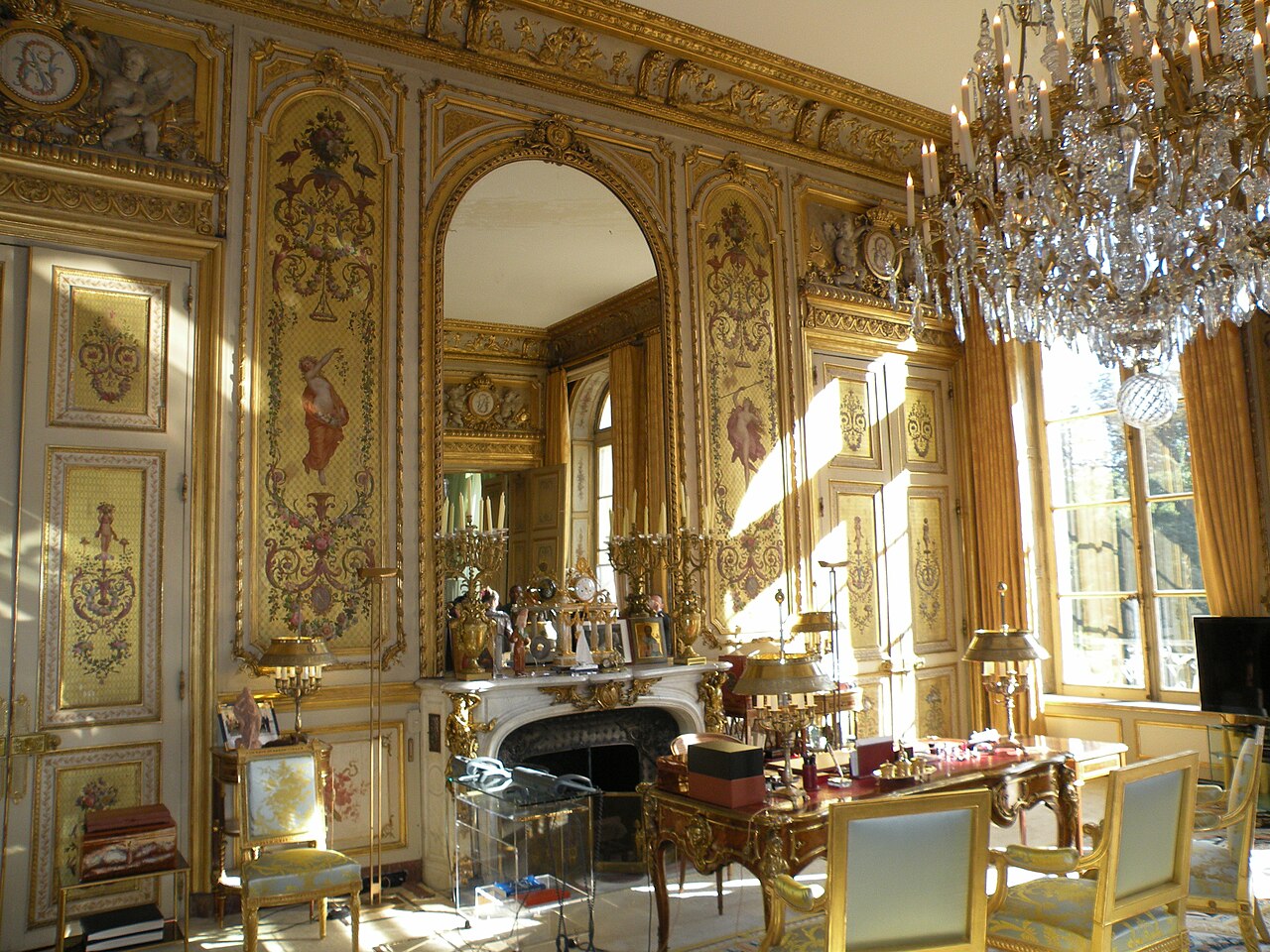
The Salon doré (Golden Room), office of the President of the French Republic.

The President's desk in the Salon doré

The Salon Pompadour.
-VIDEO :Palais de L'Elysee - Documentaire_2011

Visitors walk in the gardens of the Elysee Palace in Paris
PARIS - AUGUST 30: Elysee Palace Republican Guard of honour during a welcome ceremony on August 30, 2013 in Paris.
-VIDEO :Élysée Palace, Paris
The Republican Guard
(French: Garde républicaine) is part of the French Gendarmerie. It is responsible for providing security in the Paris area and for providing guards of honor.

Former president Nicolas Sarkozy and new president François Hollande, surrounded by Republican Guards, in the interior court during the ceremony of transmission of the mandate.
-VIDEO :Secrets et coulisses du Palais de l'Élysée
-VIDEO :Videos - Élysée Palace.
Lovelocks; Paris, France
“Love locks have come to Paris. In case you’re unaware of this phenomenon, it has become a fad for lovers to solemnize their passion by inscribing their names on a padlock, snapping it onto the railing of a bridge and throwing the key in the water.”

The Basilica of the Sacred Heart of Paris, commonly known as Sacré-Cœur Basilica and often simply Sacré-Cœur(French: Basilique du Sacré-Cœur), is a Roman Catholic church and minor basilica, dedicated to the Sacred Heart of Jesus, in Paris, France. A popular landmark, the basilica is located at the summit of the butte Montmartre, the highest point in the city. Sacré-Cœur is a double monument, political and cultural, both a national penance for the excesses of the Second Empire and socialist Paris Commune of 1871 crowning its most rebellious neighborhood, and an embodiment of conservative moral order, publicly dedicated to the Sacred Heart of Jesus, which was an increasingly popular vision of a loving and sympathetic Christ.
The Sacré-Cœur Basilica was designed by Paul Abadie. Construction began in 1875 and was finished in 1914. It was consecrated after the end of World War I in 1919.
Basilique du Sacre Coeur, vue interieure du Choeur, de l'abside et de la mosaique - Basilica of the Sacré Cœur view of the Quire, Apse and Mosaic
Equestrian Statue of King Saint Louis
Exterior of the Basilique du Sacré-Cœur de Montmartre
Equestrian Statue of Joan of Arc at Basilique du Sacré-Cœur, sculptor Hippolyte Jules Lefèbvre (1863-1935)

Basilica of the Sacré Cœur
Photo Sphere - Jul 2016:

The Basilica of Sacré-Cœur



Paris skyline from the Sacré-Cœur Basilica.






Cabaret de la Bohème, Montmartre



Paris skyline from the Sacré-Cœur Basilica.





Cabaret de la Bohème, Montmartre

Orgue de barbarie Place du tertre montmartre paris
Si vous passez place du Tertre à Montmartre, vous ne pourrez pas louper Arlette Denis qui chante avec son orgue de barbarie .
Arlette chante avec son cœur.
Arlette est aussi chanteuse, auteur-compositeur ...
Arlette continue à faire rayonner cette place ... comme aujourd'hui sous le soleil de ce 16 juin .
,
-VIDEO :Défilé d'ouverture - Festival International de la Musique Mécanique - France_2014
16ème Festival International de la Musique Mécanique en France dans le village Les Gets, plus de 400 joueurs d'orgue, chanteurs de rue, automates vivants, assurent de belles animations, avec des participants de toute l'Europe mais aussi d'Amérique du Sud avec la présence de l'Argentine, et pour la première fois le Brésil. Le thème de cette édition, est Musique mécanique et gastronomie ...!



Place du Tertre, the artist-fil

-VIDEO :Montmartre and Pigalle, Paris, France
-VIDEO :Paris, années folles.
-VIDEO :Basilique du Sacré Cœur de Montmartre Paris Arrondissement 18e
Montmartre Grape Harvest Festival :
Montmartre fetes its wine Oct 7-11
That the Butte's wine is almost undrinkable has never gotten in the way of what has to be one of this capital's best annual fests!
As with any good party, this one has something for everybody: it's part folklore, with fraternal orders from the winegrowing regions of France turning out in traditional robes and quirky hats, and part Arbor Day parade, complete with Harvest Queen, marching bands and street theater.
Paris' grape-picking tradition, dates back to the time of Asterix. Admittedly, the vine hit some hard times along the way. Most notably, a 200-year hiccup that began when the 1st-century Roman Emperor Domitian forbade vineyards in Gaul. Whether this was because he felt that the indigenous population was getting a bit too merry - or, because Italy's wine merchants didn't need the competition - is a matter of dispute...
It wasn't until the 3rd century that the Gauls were able to replant their vine stocks. By the next century, Lutetia (ancient Paris) had become one of the four winegrowing capitals of Gaul, along with Bordeaux, Narbonne and Trèves.
Paris vintages had their heyday during the Middle Ages, when they were exported to Picardy, Normandy and even England. The wines of Montmartre (or Mont Mercure, as it was then known) were particularly favored. One of them, La Goutte d'Or, was called the "king of wines."
By the 17th century, apartment construction threatened the city's grape-growers. And, come the mid-1800s, the poet Gérard de Nerval lamented, "Every year this humble slope loses another row of its scrawny vines down a rock quarry...
Farewell harvest baskets! Farewell grape harvests! Tomorrow houses will grow here instead of grapes." By WWI the last vestige of Montmartre's once-plentiful vineyards was no more. Enter Poulbot. Francisque Poulbot was a Montmartre artist, known for his paintings of chubby street urchins. In 1930 he mobilized the population of the Butte against developers planning to build on the vacant portion of land bordering the famous cabaret Au Lapin Agile. Poulbot and company occupied the site and proclaimed it their "Liberty Square" - three years later, the city of Paris planted vine stocks there.
In 1934, the intrepid mayor of Montmartre, Pierre Labric, created the fête du vin, conveniently overlooking the fact that it would be at least 10 years before the vines produced the least yield. Fortunately winegrowers in the provinces agreed to provide some 30 tons of grapes to get production rolling, and by the 1940s the Montmartre vineyard was elaborating its own nectars.
Today the quartier produces about one ton of Gamay noir (with white juice), Pinot noir and Landay grapes (thick-skinned and acidic owing to the vines' location on the north slope of the Butte), enough for about 700 bottles of Le Clos Montmartre rosé wine. The actual harvesting is done by a handful of workers from the City of Paris' parks and gardens department, and doesn't always coincide with the date of the festival. The pressing of the grapes, carried out on the place du Tertre during the 1940s, now takes place in a specially designated "cave" belonging to the 18th arrondissement's town hall. JC
This year the festival will be held October 7-11
In 1934, the intrepid mayor of Montmartre, Pierre Labric, created the fête du vin, conveniently overlooking the fact that it would be at least 10 years before the vines produced the least yield. Fortunately winegrowers in the provinces agreed to provide some 30 tons of grapes to get production rolling, and by the 1940s the Montmartre vineyard was elaborating its own nectars.
Today the quartier produces about one ton of Gamay noir (with white juice), Pinot noir and Landay grapes (thick-skinned and acidic owing to the vines' location on the north slope of the Butte), enough for about 700 bottles of Le Clos Montmartre rosé wine. The actual harvesting is done by a handful of workers from the City of Paris' parks and gardens department, and doesn't always coincide with the date of the festival. The pressing of the grapes, carried out on the place du Tertre during the 1940s, now takes place in a specially designated "cave" belonging to the 18th arrondissement's town hall. JC
This year the festival will be held October 7-11
-VIDEO :DEFILE FÊTE DES VENDANGES MONTMARTRE - Paris 12 10 2013
-VIDEO :Moulin Rouge Can Can on French TV_
Moulin Rouge Can Can on French TV - the Moulin Rouge will put on a preview of their show in order to drum up interest - sometimes in the street in front of the theater, sometimes on a television show. These are the Moulin Rouge Can-Can dancers putting on their act on French television - the Moulin Rouge performers that were on immediately prior to the Can-Can dancers would have been X-rated and banned from American television - oh, those naughty, naughty French and their gorgeous bare-breasted women showing off on public television. However, let's do hear it for these enthusiastic patriotic French Can Can dancers..
-VIDEO :Cabaret & Moulin Rouge videos

Moulin Rouge is a cabaret in Paris, France.
The house was co-founded in 1889 by Charles Zidler and Joseph Oller
-VIDEO : Paris - Moulin Rouge show and dinner
-VIDEO : Folies-Bergère FULL MOVIE 1957

The Eiffel Tower at night


The Place Vendôme Column_Par

Statue of Napoléon, Vendôme Column, Paris.
-Colonne Vendôme :
The column you will find today in the center of the square was erected by Napoleon as the Colonne d'Austerlitz. The 44 meter tall column (144 ft) is modeled after Rome's Trajan Column. It was built to commemorate the victory at Austerlitz in 1805, one of Napoleon's greatest. The column's continuous ribbon of bas-relief bronze plates by the sculptor Pierre-Nolasque Bergeret were made from
Statue of Napoleon
1200 cannons taken from the combined armies of Russia and Austria during that battle. The reliefs depict scenes during the Napoleonic Wars between 1805 and 1807.
The column was first known as the Colonne d'Austerlitz and it later was given the names of Colonne de la Victoire (Victory Column) and Colonne de la Grande Armée (Column of the Great Army). Today it is commonly known as the Colonne Vendôme.
A statue of Napoleon was installed at the top of the column in 1810. Later, the statue of the emperor was removed and the bronze melted down to provide the bronze for the recast of the equestrian statue of Henri IV on the Pont Neuf. A new statue was installed in 1833 which was later replaced by the statue that is seen today. It was erected by Napoleon III and depicts Napoleon I as a Roman emperor.
Statue of Napoleon
The column was first known as the Colonne d'Austerlitz and it later was given the names of Colonne de la Victoire (Victory Column) and Colonne de la Grande Armée (Column of the Great Army). Today it is commonly known as the Colonne Vendôme.
The Arc de Triomphe du Carrousel is a triumphal arch in Paris, located in the Place du Carrousel on the site of the former Tuileries Palace. It was built between 1806 and 1808 to commemorate Napoleon's military victories of the previous year. The more famous Arc de Triomphe de l'Étoile nearby was designed in the same year, but it took thirty years to build and is about twice the size.
Quadriga on the Arc de Triomphe du Carrousel, Paris: Peace riding in a triumphal chariot, by François-Joseph Bosio (1828).
Français : Quadrige de l'Arc de triomphe du Carroussel du Louvre: La Paix conduite sur un char de triomphe, par François-Joseph Bosio

The Tuileries Garden, looking from the large round basin toward the Place de la Concorde and Arc de Triomphe
The Tuileries Garden (French: Jardin des Tuileries, is a public garden located between the Louvre Museum and the Place de la Concorde in the 1st arrondissement of Paris. Created by Catherine de Medicis as the garden of theTuileries Palace in 1564, it was eventually opened to the public in 1667, and became a public park after the French Revolution. In the 19th and 20th century, it was the place where Parisians celebrated, met, promenaded, and relaxed
Garden of Catherine de Medicis
In July 1559, after the death of her husband, Henry II, Queen Catherine de Medicis decided to move from her residence at the chateau of Tournelles, near the Bastille, to the Louvre Palace, along with her son, the new King, François II. She decided that she would build a new palace there for herself, separate from the Louvre, with a garden modeled after the gardens of her native Florence.
At the time there was an empty area bordered by the Seine on the south, the rue Saint-Honoré on the north, the Louvre on the east, and the city walls and deep water-filled moat on the west. Since the 13th century this area was occupied by workshops, called tuileries, making tiles for the roofs of buildings. Some of land had been acquired early in the 16th century by King Francois I. Catherine acquired more land and began to build a new palace and garden on the site.
Catherine commissioned a landscape architect from Florence, Bernard de Carnesse, to build an Italian Renaissance garden, with fountains, a labyrinth, and a grotto, decorated with faience images of plants and animals, made by Bernard Palissy, whom Catherine had ordered to discover the secret of Chinese porcelain.
The garden of Catherine de Medicis was an enclosed space five hundred metres long and three hundred metres wide, separated from the new chateau by a lane. It was divided into rectangular compartments by six alleys, and the sections were planted with lawns, flower beds, and small clusters of five trees, called Quinconces; and, more practically, with kitchen gardens and vineyards.
The Tuileries was the largest and most beautiful garden in Paris at the time. Catherine used it for lavish royal festivities honoring ambassadors from Queen Elizabeth I of England and the marriage of her daughter, Marguerite de Valois, to the future Henry IV
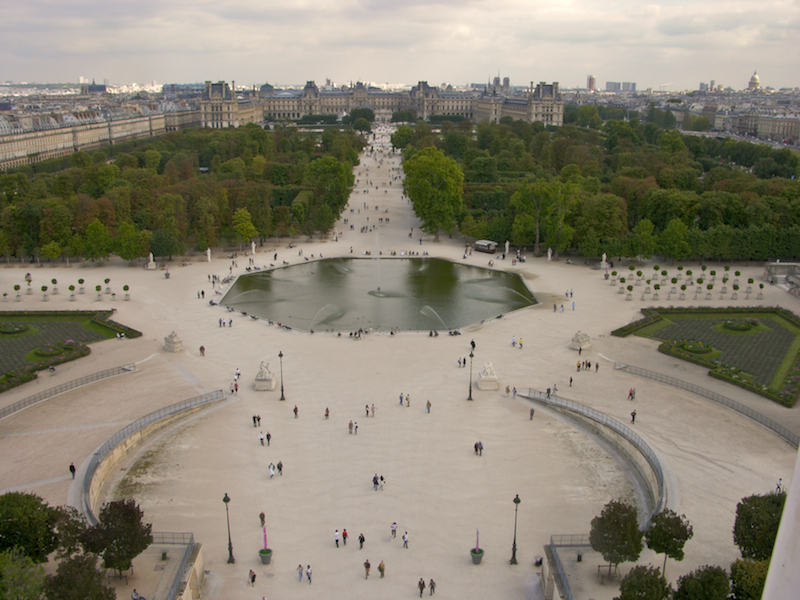
The Tuileries Garden seen from the west- the Fer à cheval (horseshoe), Grand Bassin Octagonal, and the Grande Allée ending at the Louvre

The statue of Renommée, or the fame of the king, riding the horse Pegasus, (1699) by Antoine Coysevox (1640-1720) at the west entrance of the Garden. originally in the estate of Louis XIV at Marly, moved to the Tuileries in 1719
(La renommée du roi chevauchant Pégase, par Antoine Coysevox (1640-1720), copie ayant remplacé en 1986 le marbre original déplacé au Musée du Louvre ( pavillon Richelieu, cour Marly ). Jardin des Tuileries.)
-Antoine Coysevox - Fame Riding Pegasus ('Le Cheval de Marly')
-Mercure chevauchant Pégase, par Antoine Coysevox (1640-1720), copie ayant remplacé en 1986 le marbre original déplacé au Musée du Louvre ( pavillon Richelieu, cour Marly ). Jardin des Tuileries.

-La renommée du roi chevauchant Pégase_Antoine Coysevox_ Marbre de Carrare-Jardin des Tuileries
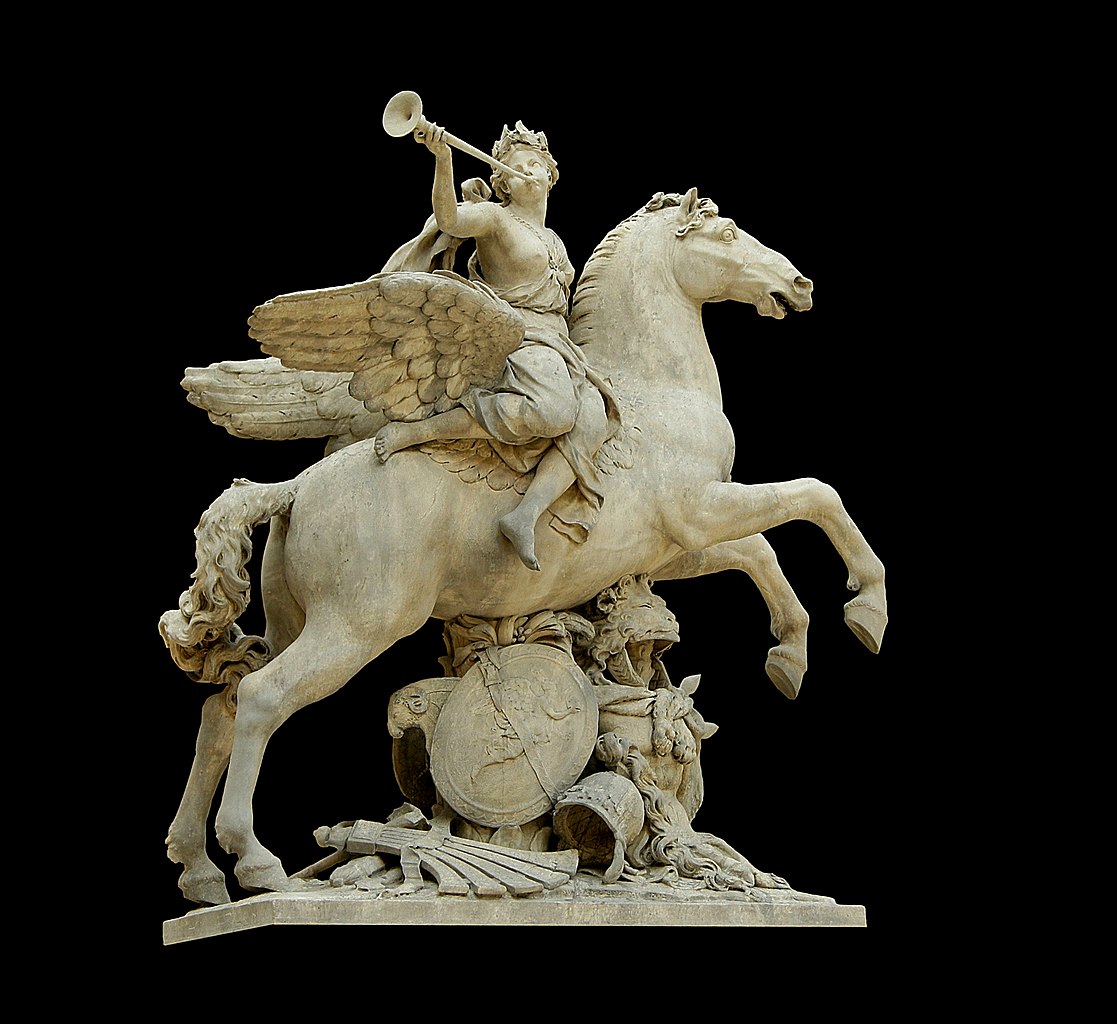
La renommée (du roi) chevauchant Pégase.

Renommée du Roi Mercure Pégase Coysevox Louvre
Fame riding Pegasus Coysevox Louvre
Statues and flowers at Tuileries garden Paris

Tuileries Garden panorama
-VIDEO :The Tuileries GardensThe Tuileries Gardens are the oldest and largest gardens in Paris.
As you enjoy a drink or lunch in one of four bars and restaurants in the gardens, you can see a large number of works of art such as the Tree of Vowels by Giuseppe Penone, Reclining Figure by Henry Moore
Nymph by Louis Auguste Lévêque or Mercury riding Pegasus by Antoine Coysevox.
Situated between the Place de la Concorde, the Louvre and Rue de Rivoli, you can enjoy a walk or sit by the Octagonal Pond on one of the gardens’ 3000 chairs.
The children can have their moment of fun, too, playing with the sailing boats available for hire or, during the summer, taking a ride on a carousel at the funfair set up in the gardens.
There’s a lot of history attached to the Tuileries: The gardens owe their name to the tile kilns built by François 1st in 1519.
A few years later, Catherine de Médicis fell in love with the place and had the Tuileries Palace built, where great receptions were held.
Later on, Henri IV experimented with silkworm farming, growing white mulberry trees to launch silk production in France.
In 1664, on Louis XIV’s orders, André Le Nôtre redesigned the Gardens, which were extended with the idea of possibly creating the Champs-Elysées.
This was the birth of the Tuileries as we know them today; they became the leading public gardens in Paris at the time.
The Palace was abandoned in 1789 and became the theatre for a number of revolutionary scenes.
Several monuments were built, dedicated to certain great men, such as the Arc de Triomphe du Carrousel, built in 1806 as a tribute to Napoleon Bonaparte and his Great Army.
The Tuileries Gardens acted as a lung for the capital, which was redesigned partly as a result of the Gardens.
During the changes in regime, the composition of the Gardens gradually changed and works were carried out in the early 90s, in keeping with the style of André Le Nôtre.
To the east of the Gardens you can see the Orangery, which was originally used to house Claude Monet’s Water Lilies.
To the west is the Jeu de Paume gallery and the Terrasse des Feuillants.
The Tuileries Gardens attracts over 14 million visitors every year.
-VIDEO :Visite du Jardin des Tuileries à Paris(2012)Promenade dans le Jardin des Tuileries à Paris (automne 2012 - mois de novembre 2012)
-VIDEO :Le jardin des Tuileries à Paris(2013)Situé entre la pyramide, le musée du Louvre et la place de la concorde, le jardin des Tuileries offre une agréable promenade aux visiteurs même en hiver.
Illustration musicale et sonore JMF.
Sculptures in the Tuileries Garden

Mercury riding Pegasus, (1701–02) by Antoine Coysevox (1640-1720). Originally at Marly, moved to the Tuileries in 1719 and placed at the west gate of the garden. In 1986 the original of marble was moved to the Louvre and replaced by a copy.
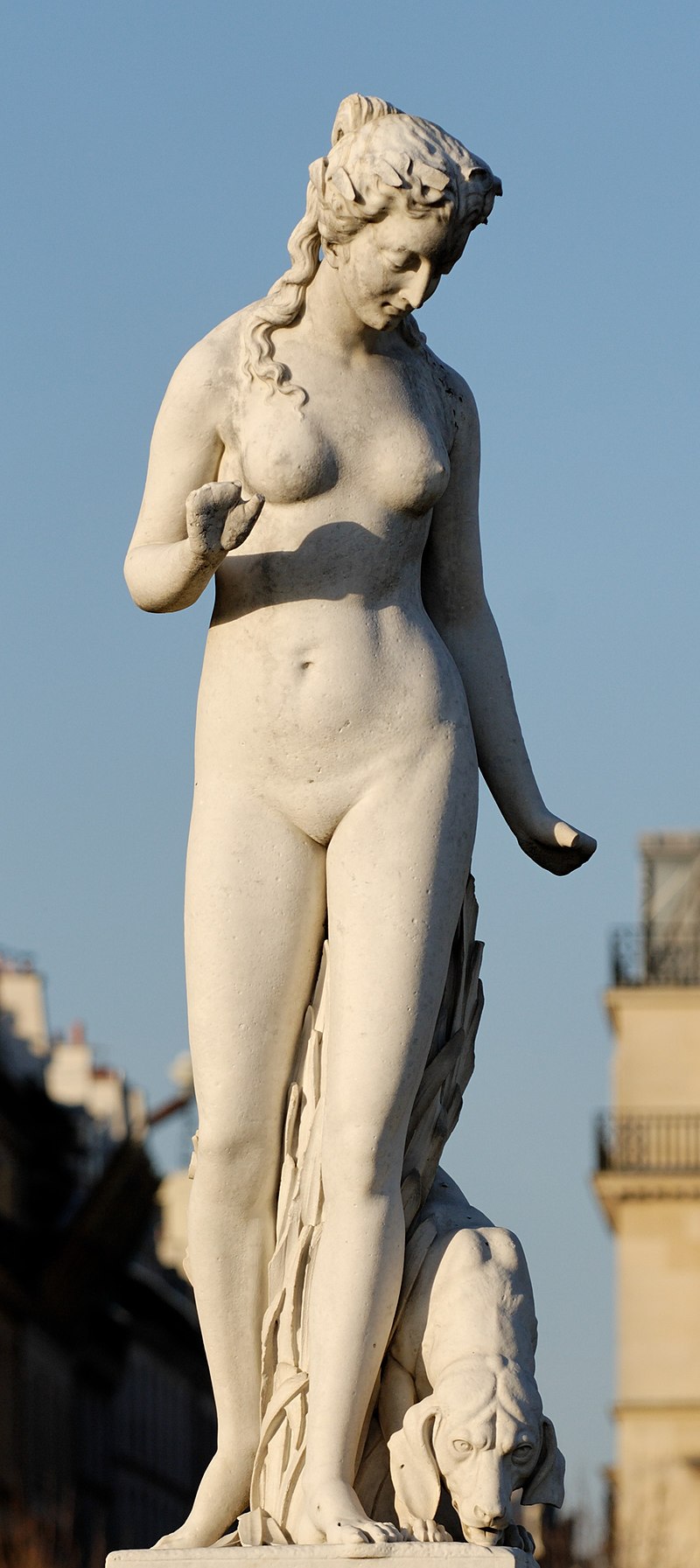
Nymphe, by Louis Auguste Lévêque, (1866). In the Grand Carré, at the beginning of the Grand Allée.

Auguste Rodin, 1881-ca.1899, Éve, bronze

Le Baiser (The Kiss), by Auguste Rodin, (1934 cast of the marble original), West Terrace

flowers in the garden outside the Louvre - Paris, Ile-de-France
- France_Louvre Museum_ Luxembourg Gardens_Notre Dame De Paris

Aerial view of the Louvre Palace

Courtyard of the Louvre Museum, with the Pyramid


France - Paris, Louvre






Artemis_was the Hellenic goddess of the hunt, wild animals, wilderness, childbirth, virginity and protector of young girls, bringing and relieving disease in women; she often was depicted as a huntress carrying a bow and arrows.The Diana of Versailles, a Roman copy of a Greek sculpture by Leochares

Venus de Milo_Aphrodite of Milos (Greek: Ἀφροδίτη τῆς Μήλου, Aphroditē tēs Mēlou), better known as the Venus de Milo, is an ancient Greekstatue and one of the most famous works of ancient Greek sculpture. Created sometime between 130 and 100 BC, it is believed to depict Aphrodite, the Greek goddess of love and beauty (Venus to the Romans). It is a marble sculpture, slightly larger than life size at 203 cm (6 ft 8 in) high. The arms and original plinth were lost following its discovery. From an inscription that was on its plinth, it is thought to be the work of Alexandros of Antioch; earlier, it was mistakenly attributed to the master sculptor Praxiteles. It is currently on permanent display at the Louvre Museum in Paris.

The Galerie d'Apollon is a part of the Louvre, famous for its high vaulted ceilings with painted decorations.




-Liberty Leading the People in Louvre,Paris,France.

-Liberty Leading the People (French: La Liberté guidant le peuple) is a painting by Eugène Delacroix commemorating the July Revolution of 1830, which toppled King Charles X of France. A woman personifying the concept and the goddess of Liberty leads the people forward over the bodies of the fallen, holding the flag of the French Revolution – the tricolor flag which is still France's flag today – in one hand and brandishing a bayonetted musket with the other. The figure of Liberty is also viewed as a symbol of France and the French Republic known as Marianne.





-Liberty Leading the People in Louvre,Paris,France.
-Liberty Leading the People (French: La Liberté guidant le peuple) is a painting by Eugène Delacroix commemorating the July Revolution of 1830, which toppled King Charles X of France. A woman personifying the concept and the goddess of Liberty leads the people forward over the bodies of the fallen, holding the flag of the French Revolution – the tricolor flag which is still France's flag today – in one hand and brandishing a bayonetted musket with the other. The figure of Liberty is also viewed as a symbol of France and the French Republic known as Marianne.

The Raft of the Medusa (French: Le Radeau de la Méduse) is an oil painting of 1818–1819 by the FrenchRomantic painter and lithographer Théodore Géricault (1791–1824). Completed when the artist was 27, the work has become an icon of French Romanticism. At 491 cm × 716 cm (193.3 in × 282.3 in), it is an over-life-size painting that depicts a moment from the aftermath of the wreck of the French naval frigate Méduse, which ran aground off the coast of today's Mauritania on July 5, 1816. At least 147 people were set adrift on a hurriedly constructed raft; all but 15 died in the 13 days before their rescue, and those who survived endured starvation and dehydration and practiced cannibalism. The event became an international scandal, in part because its cause was widely attributed to the incompetence of the French captain perceived to be acting under the authority of the recently restored French monarchy. In reality, King Louis XVIII had no say in the captain's appointment, since monarchs were not directly involved in appointments made to vessels like a naval frigate. The appointment of the vicomte de Chaumareys as captain of the Méduse would have been a routine naval appointment, made within the Ministry of the Navy

The Intervention of the Sabine Women is a 1799 painting by the French painter Jacques-Louis David.The painting depicts Romulus's wife Hersilia – the daughter of Titus Tatius, leader of the Sabines – rushing between her husband and her father and placing her babies between them. A vigorous Romulus prepares to strike a half-retreating Tatius with his spear, but hesitates.
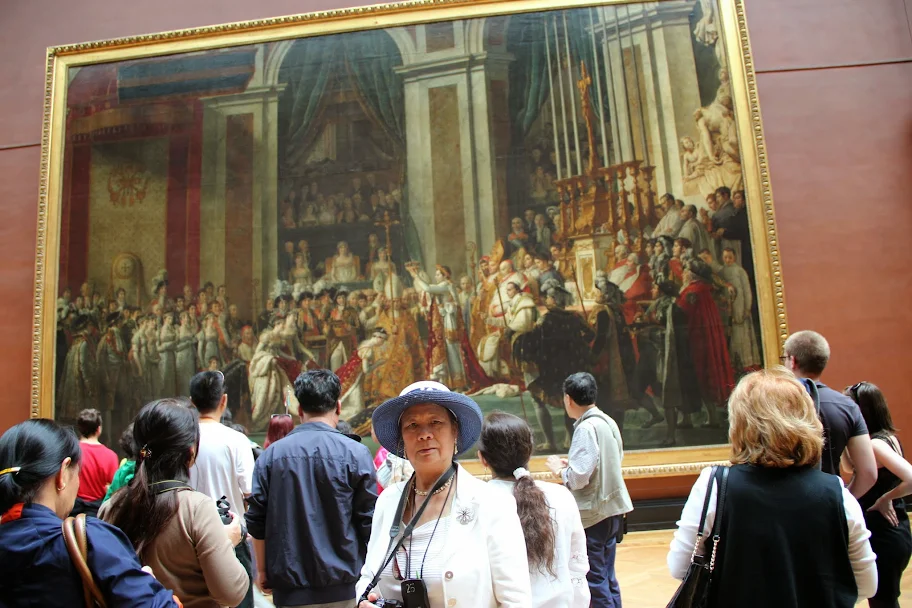
The coronation of Napoleon Ion 2 December 1804 at Notre-Dame in an 1807 painting byJacques-
Louis David

Oath of the Horatii (French: Le Serment des Horaces), is a large painting by the French artist Jacques-Louis David painted in 1784 and now on display in the Louvre in Paris. The painting immediately became a huge success with critics and the public, and remains one of the best known paintings in the Neoclassical style.
It depicts a scene from a Roman legend about a dispute between two warring cities; Rome and Alba Longa, when three brothers from a Roman family, the Horatii, agree to end the war by fighting three brothers from a family of Alba Longa, the Curiatii. The three brothers, all of whom appear willing to sacrifice their lives for the good of Rome, are shown saluting their father who holds their swords out for them. The principal sources for the story behind David's Oath are the first book of Livy (sections 24-6) which was elaborated by Dionysius in book 3 of his Roman Antiquities. However, the moment depicted in David's painting is his own invention.
It grew to be considered a paradigm of neoclassical art. The painting increased David's fame, allowing him to take on his own students

The Mona Lisa (Monna Lisa or La Gioconda in Italian; La Joconde in French) is a half-length portrait of a woman by the Italian artist Leonardo da Vinci, which has been acclaimed as "the best known, the most visited, the most written about, the most sung about, the most parodied work of art in the world."
The painting, thought to be a portrait of Lisa Gherardini, the wife of Francesco del Giocondo, is in oil on a white Lombardy poplarpanel, and is believed to have been painted between 1503 and 1506, although Leonardo may have continued working on it as late as 1517. It was acquired by King Francis I of France and is now the property of the French Republic, on permanent display at The Louvre museum in Paris since 1797.
The ambiguity of the subject's expression, which is frequently described as enigmatic, the monumentality of the composition, the subtle modeling of forms and the atmospheric illusionism were novel qualities that have contributed to the continuing fascination and study of the work.
-VIDEO :Secrets of the Mona Lisa DOCUMENTARY DISCOVERY CHANNEL
The Wedding at Cana :
The Wedding at Cana :
| Artist | Paolo Veronese |
|---|---|
| Year | 1563 |
| Type | Oil on canvas |
| Dimensions | 666 cm × 990 cm (262 in × 390 in) |
| Location | Louvre, Paris |

The piece was commissioned in 1562 by the Benedictine Monastery of San Giorgio Maggiore in Venice, Italy, and completed in fifteen months by the year 1563. It hung in the refectory of the monastery for 235 years, until it was plundered by Napoléon in 1797 and shipped to Paris. The painting was cut in half for the journey and stitched back together in Paris. It was not returned in the post-Napoléonic conciliation treaties which pursued some restitution of looted artworks, and in its stead a feebleCharles Le Brun painting (now at the Gallerie dell'Accademia) was shipped to Venice.
The painting was taken to Brest and stored in a box during the Franco-Prussian War and rolled up and moved around France in a truck during World War II.
In 1989, the Louvre began a $1 million renovation, comparable to the work done on the Sistine Chapel ceiling. A group of artists calling themselves the Association to Protect the Integrity of Artistic Heritage protested and demanded a review of the restoration. In June 1992, with the restoration incomplete, the Louvre was embarrassed when the painting suffered damage in two separate incidents. In the first, the canvas was spattered by water from a leaking air vent. In the second, two days later, curators were raising the 1.5 ton painting to a higher position on the wall when one of the supports gave way, and the entire painting toppled to the floor. The metal framework tore five holes in the canvas, one of them four feet long; architectural and background areas of the painting were affected, but no faces. The museum was criticized for keeping the incident private for an entire month while rumors swirled.
On 11 September 2007, the 210th anniversary of the looting of the painting by Napoleon's troops, a facsimile of the original was hung in its original place in the Palladian Refectory. The computerized facsimile was commissioned by the Giorgio Cini Foundation of Venice with the collaboration of the Musée du Louvre, Paris, where the original remains, and made by Factum Arte, a Madrid-based team of artists and conservators, founded and directed by the British artist Adam Lowe. It consists of 1,591 computer graphic files. (See Returning "Les Noces de Cana").
The Wedding at Cana (or The Wedding Feast at Cana) is a massive painting by the late-Renaissance or Mannerist Italian painter Paolo Veronese. It is on display in the Musée du Louvre in Paris, where it is the largest painting in that museum's collection.


AUDREY HEPBURN
The Winged Victory of Samothrace_The Winged Victory of Samothrace, also called the Nike of Samothrace,is a 2nd-century BC marble sculpture of the Greek goddess Nike (Victory). Since 1884, it has been prominently displayed at the Louvre and is one of the most celebrated sculptures in the world. H.W. Janson described it as "the greatest masterpiece of Hellenistic sculpture."
-Musee du Louvre, Paris, 2013:
Treasures of the Louvre_BBC :
-VIEW :360'Virtual Tours and Panoramic images_The Louvre Museum (Musée du Louvre)
L'église de la Madeleine ,Madeleine Church; more formally, L'église Sainte-Marie-Madeleine; less formally, just La Madeleine) is a Roman Catholic church occupying a commanding position in the 8th arrondissement of Paris.
The Madeleine Church was designed in its present form as a temple to the glory of Napoleon's army. To its south lies the Place de la Concorde, to the east is the Place Vendôme, and to the west Saint-Augustin, Paris.

The Madeleine Church
Interior of the Église de la Madeleine, Paris


The Hôtel de Sully is a hôtel particulie

Hôtel de Sully, rue Saint-Antoine, Paris
The financier Mesme Gallet built the hôtel, with gardens and an orangery, between 1625 and 1630. The building was designed by the architect Jean Androuet du Cerceau. The site was chosen to give access to the Place Royale - today the Place des Vosges - and was located in the Marais, at the time a fashionable district of Paris.
Maximilien de Béthune, duc de Sully, former Superintendent of Finances to King Henri IV, purchased it on 23 February 1634. He completed the decoration of the hôtel, and spent his last years living there. His grandson Maximilien commissioned the architect François Le Vau, son of Louis Le Vau, to build an additional wing in 1660, to the west of the garden. The Hôtel de Sully still bears the name of this family, who owned the building into the 18th century.
The hôtel then passed through the hands of various owners, becoming an investment property in the 19th century. Various additions and alterations were made, to accommodate trades, craftsmen and other tenants. In 1862 it was classified as a monument historique, and new owners, more concerned with conservation, gradually restored the building. It became a state-owned property in 1944. A long restoration programme was then undertaken, which was completed with the repair of the Orangery in 1973.
Since 1967 it has been the home of the Caisse nationale des monuments historiques et des sites, which in 2000 became the Centre des monuments nationaux. This public body, under the supervision of the Ministry of Culture and Communication, is responsible for the management of historic buildings and monuments in state care.

Hôtel de Sully, Sphinx, c.a. 1625

2013-06-16_At The Hôtel de Sully

Place des Vosges, former Place Royale, (renamed in 1800), begun in 1605 by Henry IV, inaugurated in 1612 by his son, Louis XIII, was the first prestigious residential square in Paris.
The Place des Vosges is the oldest planned square in Paris and one of the finest in the city. It is located in the Marais district, and it straddles the dividing-line between the 3rd and 4th arrondissements of Paris.
Originally known as the Place Royale, the Place des Vosges was built by Henri IV from 1605 to 1612. A true square (140 m × 140 m), it embodied the first European program of royal city planning. It was built on the site of the Hôtel des Tournelles and its gardens: at a tournament at the Tournelles, a royal residence,Henri II was wounded and died. Catherine de Medicis had the Gothic complex demolished, and she removed to the Louvre Palace.
The Place des Vosges, inaugurated in 1612 with a grand carrousel to celebrate the wedding of Louis XIII and Anne of Austria, is the prototype of all the residential squares of European cities that were to come. What was new about the Place Royale in 1612 was that the housefronts were all built to the same design, probably by Baptiste du Cerceau, of red brick with strips of stone quoins over vaulted arcades that stand on square pillars. The steeply-pitched blue slate roofs are pierced with discreet small-paned dormers above the pedimented dormers that stand upon the cornices. Only the north range was built with the vaulted ceilings that the "galleries" were meant to have. Two pavilions that rise higher than the unified roofline of the square center the north and south faces and offer access to the square through triple arches. Though they are designated the Pavilion of the King and of the Queen, no royal personage has ever lived in the aristocratic square. The Place des Vosges initiated subsequent developments of Paris that created a suitable urban background for the French aristocracy.
Before the square was completed, Henri IV ordered the Place Dauphine to be laid out. Within a mere five-year period the king oversaw an unmatched building scheme for the ravaged medieval city: additions to the Louvre Palace, the Pont Neuf, and the Hôpital Saint Louis as well as the two royal squares.
Cardinal Richelieu had an equestrian bronze of Louis XIII erected in the center (there were no garden plots until 1680). The original was melted down in the Revolution; the present version, begun in 1818 by Louis Dupaty and completed by Jean-Pierre Cortot, replaced it in 1825. The square was renamed in 1799 when the département of the Vosges became the first to pay taxes supporting a campaign of the Revolutionary army. The Restoration returned the old royal name, but the short-livedSecond Republic restored the revolutionary one in 1848.
Today the square is planted with a bosquet of mature lindens set in grass and gravel, surrounded by clipped lindens.
-VIDEO :Marais / Place des Vosges / Rue des Rosiers, Paris, France(2011)

One of Cortot's four fountains, 1825.
-VIDEO :Paris, Place des Vosges (Full HD)

Cardinal Richelieu had an equestrian bronze of Louis XIII erected in the center_The Place des Vosges

The Place des Vosges is the oldest planned square in Paris.
-VIDEO :Flash Mob N°5 - 70 ans de la libération de Paris - Place des Vosges(1944-2014).
Freeze & Dance Mob multi-style (Lindy Hop, Rock'n'Roll, West Coast Swing) pour célébrer les 70 ans de la libération de Paris (août 1944.) , en partenariat avec le Musée Carnavalet.

2013-06-16_Place de Vosges
-VIDEO :A Walk Around Le Marais District of Paris_2019.


Luxembourg Gardens

The Jardin du Luxembourg

LE PALAIS ET JARDIN DU LUXEMBOURG

Photo Sphere - Aug 2016:
Joe Dassin & Joelle_Printemps 2011

The palace of Luxembourg, in the Luxembourg garden, Paris, at sunset.
-VIDEO :A Visit to the Luxembourg Gardens in Paris_(2011)
Tuileries Garden
Le jardin des Tuileries, vue de la place de la Concorde. Au premier plan, un bassin. Au fond le Louvre. Vue aérienne prise de la grande roue.
- A Paris_ Yves Montand.
-My Photo Album : Visiting Paris , France :
|










No comments:
Post a Comment